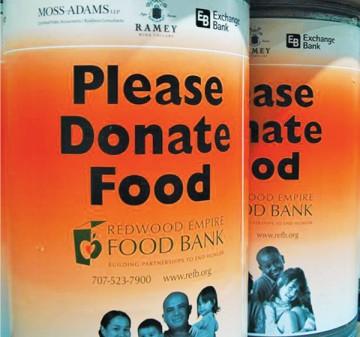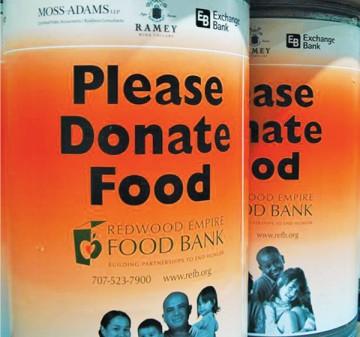Despite all the luscious green grapevines and diverse dining options present in Sonoma County, some residents are still not getting the food they need to get by on a daily basis.
The Sonoma County Hunger Index showed that the county missed 34 million meals in 2015. If spread evenly, this meant that each of that year’s 500,000 Sonoma County inhabitants missed one meal per week. In a February 2015 study commissioned by California State University Chancellor Timothy White, California State University faculty found 21 percent of students on their campuses to be food insecure, according to a January 2016 Cal State Report.
In addition, a Feeding America study showed that one in 10 food-deprived U.S. adults were students in 2013. Given those numbers, it becomes clear that hunger is a more widespread issue for college students than many might expect.
Allison Goodwin, director of programs at Redwood Empire Food Bank, stressed the importance of remembering that college students don’t always get the food they need.
“I think people are finally paying attention to the fact that college students are in that niche,” said Goodwin.
There are a variety of on-campus eating options for Sonoma State University students, including restaurants like Lobo’s and Weyden + Brewster, along with vending machines in halls throughout campus. But for cost-free food, students dealing with hunger or food insecurity may find more examples off-campus.
One Sonoma County food pantry is run by students, for students at Santa Rosa Junior College. The Phi Theta Kappa club organizes the food pantry, which is held Mondays and Tuesdays at the main campus’ Barnett Hall Kiosk. Phi Theta Kappa co-presidents Elijah Huerta and Sabrina Rodrigues order fresh fruit, vegetables, frozen burritos and more from the Redwood Empire Food Bank to serve hungry students.
“It just feels good to give back,” said Huerta. “It’s definitely given me a lot more responsibility, being in charge of something that’s genuinely doing good for the community.”
Huerta and Rodrigues said food is first-come, first-served with no discrimination toward any group of students.
“It’s just crazy how many students have to choose between paying for college or paying for food, or skipping meals to make sure they can buy their books,” said Rodrigues. “It’s such an important resource to be able to have your own easy, accessible food.”
Rodrigues said that Phi Theta Kappa donates leftover food to nearby homeless shelters and churches, such as the Redwood Gospel Mission in Santa Rosa.
“So much food goes to waste that doesn’t need to, it’d be silly not to take advantage of this opportunity,” said Rodrigues.
Another group providing leftover food to Sonoma County is Farm to Pantry, a Healdsburg nonprofit organization that harvests leftover crops through a process called gleaning. Farm to Pantry has gleaned over 120 tons of fresh produce since it started in Oct. 2008, according to its website. Program Director Dani Wilcox said they deliver around 2,000 pounds of surplus produce per week to places like Redwood Empire Food Bank and after-school programs in Healdsburg, Geyserville and Windsor. She said staff and volunteers box up the crops and deliver them after gleaning at Healdsburg farms that have leftovers.
“It’s about what’s available,” said Wilcox. “If a farm doesn’t have anything, we’re not going to go.”
Wilcox said that anyone who wants to volunteer can sign up, and that Farm to Pantry’s services are aimed at anybody with limited access to healthy produce.
“We do connect to community—we feel that’s how we accomplish what we do,” said Wilcox.
Beyond the Sonoma County community, University of California college campuses are working together to combat student hunger. Since its launch in July 2014, the UC Global Food Initiative has aimed to implement food studies into curriculum, operations, policy, research and service, according to the UC Office of the President’s website.
“The University of California Global Food Initiative addresses one of the critical issues of our time: How to sustainably and nutritiously feed a world population expected to reach eight billion by 2025,” said Katie Maynard, sustainability coordinator at UC Santa Barbara.
Maynard said the college’s Edible Campus program uses campus property for food-growing projects like an urban garden and a student farm.
“The Edible Campus Program works to grow food in underutilized spaces on campus to supply fresh produce for students in need,” said Maynard. “We have four major growing projects and one major educational initiative currently.”
When asked how other universities can utilize the program’s methods to feed its own undernourished students, Maynard said their model is widely applicable since it meets the requirements of all local, state and national regulations.
“We have documented our efforts in detail and are happy to share our best practices with any students from other campuses that need support navigating through the campus approval process,” said Maynard.
Regardless of where they’re from, some students may feel insecure asking for food. Huerta said that undernourished students should find an outlet for meals, whether it’s a food bank or a youth group.
“It’s ultimately just a thing you need to get over it, if one of your struggles is being hungry, then you need to find a way to provide yourself with food,” said Huerta.





![[Both photos courtesy of sonoma.edu]
Ming-Ting Mike Lee stepped in as the new SSU president following Sakakis resignation in July 2022](https://sonomastatestar.com/wp-content/uploads/2024/04/CC4520AB-22A7-41B2-9F6F-2A2D5F76A28C-1200x1200.jpeg)



























